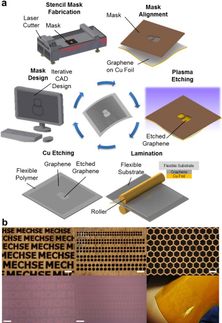Breakthrough may lead to industrial production of graphene devices
With properties that promise faster computers, better sensors and much more, graphene has been dubbed the 'miracle material'. But progress in producing it on an industrial scale without compromising its properties has proved elusive. University of Groningen scientists may now have made a breakthrough. Their results will be published in Nano Letters.
Graphene is a special material with crystals that are just one atom thick. Electrons pass through it with hardly any resistance at all, and despite being very flexible, it is stronger than any metal. The discoverers of graphene, Andre Geim and Konstantin Novoselov, famously made it by peeling graphite with Scotch tape until they managed to isolate a single atomic layer: graphene. It won them the 2010 Nobel Prize in Physics.
'The challenge is to find a substrate that not only preserves the properties of graphene, but also enables scalable production.', says Stefano Gottardi, PhD student at the University of Groningen Zernike Institute for Advanced Materials. A good candidate is chemical vapour deposition. Here heat is used to vaporize a carbon precursor like methane, which then reacts with a catalytically active substrate to form graphene on its surface. A transition metal is normally used as the substrate. However, not only does the transition metal act as a support, but it also tends to interact with the graphene and modify - or even deteriorate - its outstanding properties.
To restore these properties after growth on the metal, the graphene has to be transferred to a non-interacting substrate, but this transfer process is cumbersome and often introduces defects. Nevertheless, many scientists are trying to improve graphene growth on transition metals, mostly using copper foil as the substrate.
This is what the Surfaces and Thin Films group of Gottardi's supervisors Meike Stöhr and Petra Rudolf did too. 'When we analyzed a sample of graphene on copper, we made some strange observations', Stöhr recalls. The observations suggested that alongside the copper some copper oxide was also present. Indeed, a nice graphene film appeared to have formed on the copper oxide, and as oxidized metals might leave the properties of graphene unaltered, this was a potentially important observation.
The Groningen team began to study this possibility in more detail. That was three years ago. Since then, Gottardi and his colleagues have managed to successfully grow graphene on copper oxide. This achievement together with an in-depth characterization of graphene's properties will be published in Nano Letters. The team also reports the remarkable finding that graphene on copper oxide is decoupled from the substrate, which means that it preserves its peculiar electronic properties.
The results could be far-reaching. Stöhr: 'Other labs need to reproduce our findings, and quite a bit of work needs to be done to optimize growth conditions.' The best case scenario would be that large single-domain crystals of graphene could be grown on copper oxide. If this proves to be the case, it should then be possible to use lithographic techniques to make all sorts of electronic devices from graphene in a commercially viable manner. An unexpected observation three years ago may thus prove to be the start of a new era of graphene electronics.
Original publication
Original publication
Stefano Gottardi, Kathrin Müller, Luca Bignardi, Juan Carlos Moreno-López, Tuan Anh Pham, Oleksii Ivashenko, Mikhail Yablonskikh, Alexei Barinov, Jonas Björk, Petra Rudolf, Meike Stöhr; "Comparing Graphene Growth on Cu(111) versus Oxidized Cu(111)."; Nano Letters.
Organizations
Other news from the department science

Get the chemical industry in your inbox
By submitting this form you agree that LUMITOS AG will send you the newsletter(s) selected above by email. Your data will not be passed on to third parties. Your data will be stored and processed in accordance with our data protection regulations. LUMITOS may contact you by email for the purpose of advertising or market and opinion surveys. You can revoke your consent at any time without giving reasons to LUMITOS AG, Ernst-Augustin-Str. 2, 12489 Berlin, Germany or by e-mail at revoke@lumitos.com with effect for the future. In addition, each email contains a link to unsubscribe from the corresponding newsletter.




























































